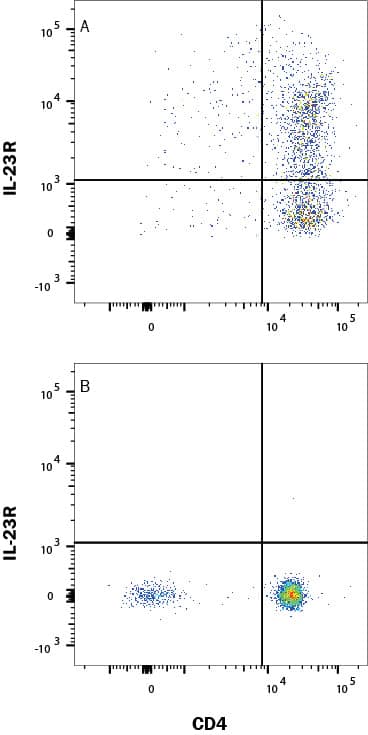Human IL-23R Alexa Fluor® 700-conjugated Antibody
R&D Systems, part of Bio-Techne | Catalog # FAB14001N


Key Product Details
Species Reactivity
Validated:
Cited:
Applications
Validated:
Cited:
Label
Antibody Source
Product Specifications
Immunogen
Gly24-Ile354
Accession # Q5VWK5
Specificity
Clonality
Host
Isotype
Scientific Data Images for Human IL-23R Alexa Fluor® 700-conjugated Antibody
Detection of IL‑23 R in Human PBMCs by Flow Cytometry.
Human peripheral blood mononuclear cells (PBMCs) (A) cultured with plate-bound 5 μg/mL anti-Human CD3, 2 μg/mL anti-Human CD28 (AF-342-PB), 20 ng/mL Recombinant Human IL-2 (202-GMP), 10 ng/mL TGF-beta (100-B), 20 ng/mL Recombinant Human IL-23 (1290-IL), 40 ng/mL Recombinant Human IL-6 (206-IL), 10 ng/mL Recombinant Human IL-1 beta (201-LB), and 10 μg/mL anti-Human IFN-gamma (AF-285-NA) for 7 days to induce Th17 development or (B), resting, were stained with Mouse Anti-Human CD4 PE-conjugated Monoclonal Antibody (FAB3791P) and Mouse Anti-Human IL-23 R Alexa Fluor® 700-conjugated Monoclonal Antibody (Catalog # FAB14001N). Quadrant markers were set based on Mouse IgG2B Isotype Control (IC0041N). Staining was performed using our Staining Membrane-associated Proteins protocol.Applications for Human IL-23R Alexa Fluor® 700-conjugated Antibody
Flow Cytometry
Sample: Human peripheral blood mononuclear cells (PBMCs) cultured with plate-bound 5 μg/mL anti-Human CD3, 2 μg/mL anti-Human CD28 (Catalog # AF-342-PB), 20 ng/mL Recombinant Human IL-2 (Catalog # 202-GMP), 10 ng/mL TGF-beta (Catalog # 100-B), 20 ng/mL Recombinant Human IL-23 (Catalog # 1290-IL), 40 ng/mL Recombinant Human IL-6 (Catalog # 206-IL), 10 ng/mL Recombinant Human IL-1 beta (Catalog # 201-LB), and 10 μg/mL anti-Human IFN-gamma (Catalog # AF-285-NA) for 7 days to induce Th17 differentiation
Formulation, Preparation, and Storage
Purification
Formulation
Shipping
Stability & Storage
- 12 months from date of receipt, 2 to 8 °C as supplied.
Background: IL-23R
Interleukin 23 (IL-23) is a heterodimeric cytokine composed of two disulfide-linked subunits, a p19 subunit that is unique to IL-23, and a p40 subunit that is shared with IL-12 (1 - 5). The functional IL-23 receptor complex consists of two receptor subunits, the IL-12 receptor beta 1 subunit (IL-12 R beta1) and the IL-23-specific receptor subunit (IL-23 R) (3). Human IL-23 R cDNA encodes a 629 aa type I transmembrane protein with a 23 aa residue signal peptide, a 330 aa residue extracellular domain, a 23 aa residue transmembrane domain and a 253 aa residue cytoplasmic region. IL-23 R shares structural features with the IL-12 R beta2, including an N-terminal Ig-like domain, two cytokine receptor domains and multiple glycosylation sites in the extracellular domain. IL-23 R lacks the three extracellular membrane-proximal fibronectin-type III domains present on IL-12 R beta2. IL-23 R has a WQPWS sequence in the transmembrane-proximal cytokine receptor domain similar to the cytokine receptor signature WSXWS motif. The cytoplasmic region of IL-23 R has three potential Src homology 2 domain-binding sites and two potential Stat-binding sites. The gene for human IL-23 R is located on human chromosome 1 within 150 kb of IL-12 R beta2. Human and mouse IL-23 R share 66% amino acid sequence identity. Based on quantitative real-time PCR, human IL-23 R mRNA is expressed in a human Th1 and Th0 clone as well as several NK cell lines and clones. Low but detectable levels of IL-23 R mRNA is also expressed in EBV-transformed B cells and activated PBMC. IL-23 initiates a signal transduction cascade similar to that of IL-12, and involves Jak2, Tyk2, Stat1, Stat3, Stat4, and Stat5. IL-23 has biological activities that are similar to, but distinct from IL-12.
References
- Oppmann, B. et al. (2000) Immunity 13:715.
- Lankford, C.S. and D.M. Frucht (2003) J. Leukoc. Biol. 73:49.
- Parham, C. et al. (2002) J. Immunol. 168:5448.
- Belladonna, M.L. et al. (2002) J. Immunol. 168:5448.
- Aggarwal, S. et al. (2003) J. Biol. Chem. 278:1910.
Long Name
Alternate Names
Gene Symbol
UniProt
Additional IL-23R Products
Product Specific Notices for Human IL-23R Alexa Fluor® 700-conjugated Antibody
This product is provided under an agreement between Life Technologies Corporation and R&D Systems, Inc, and the manufacture, use, sale or import of this product is subject to one or more US patents and corresponding non-US equivalents, owned by Life Technologies Corporation and its affiliates. The purchase of this product conveys to the buyer the non-transferable right to use the purchased amount of the product and components of the product only in research conducted by the buyer (whether the buyer is an academic or for-profit entity). The sale of this product is expressly conditioned on the buyer not using the product or its components (1) in manufacturing; (2) to provide a service, information, or data to an unaffiliated third party for payment; (3) for therapeutic, diagnostic or prophylactic purposes; (4) to resell, sell, or otherwise transfer this product or its components to any third party, or for any other commercial purpose. Life Technologies Corporation will not assert a claim against the buyer of the infringement of the above patents based on the manufacture, use or sale of a commercial product developed in research by the buyer in which this product or its components was employed, provided that neither this product nor any of its components was used in the manufacture of such product. For information on purchasing a license to this product for purposes other than research, contact Life Technologies Corporation, Cell Analysis Business Unit, Business Development, 29851 Willow Creek Road, Eugene, OR 97402, Tel: (541) 465-8300. Fax: (541) 335-0354.
For research use only